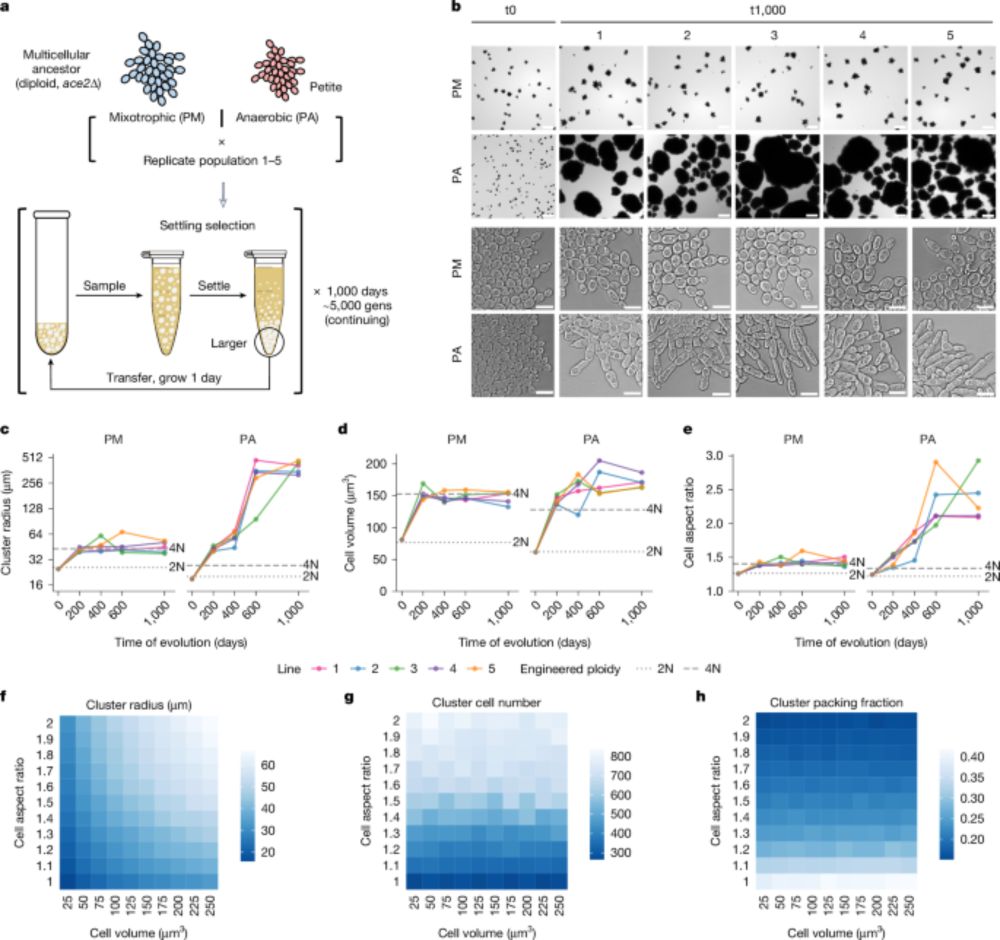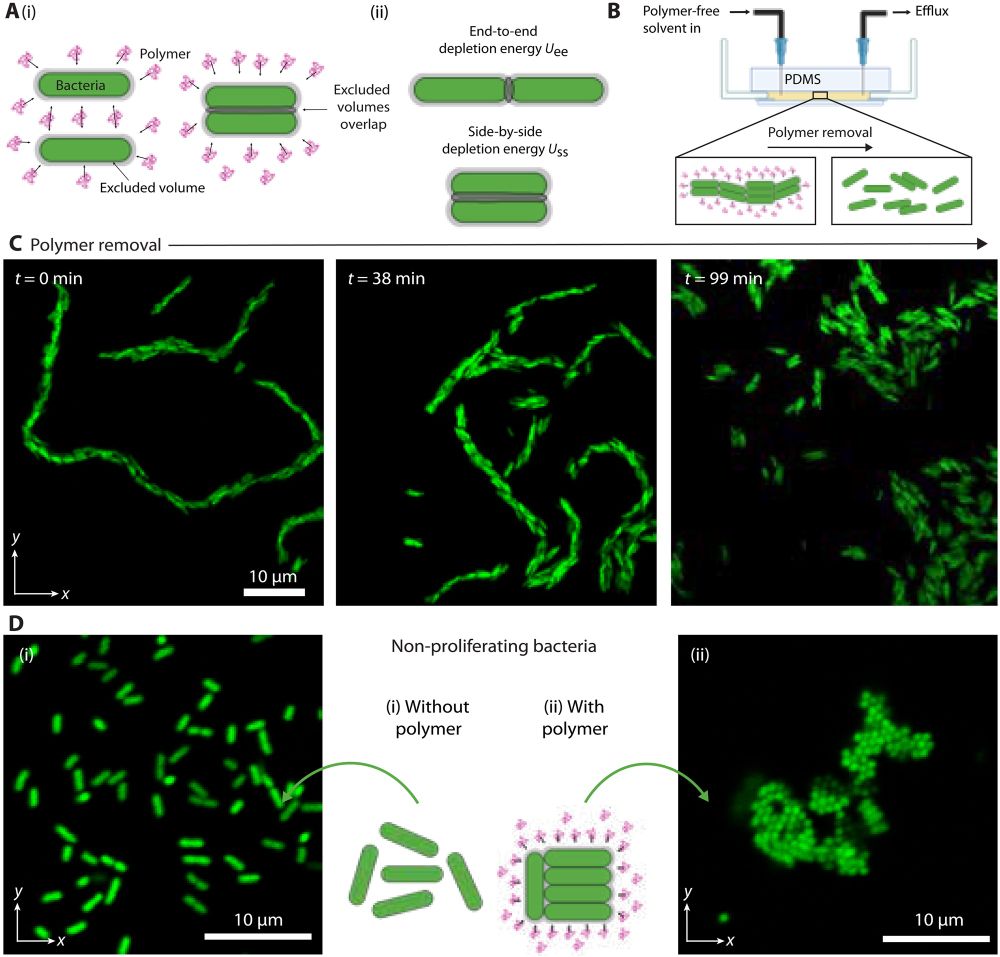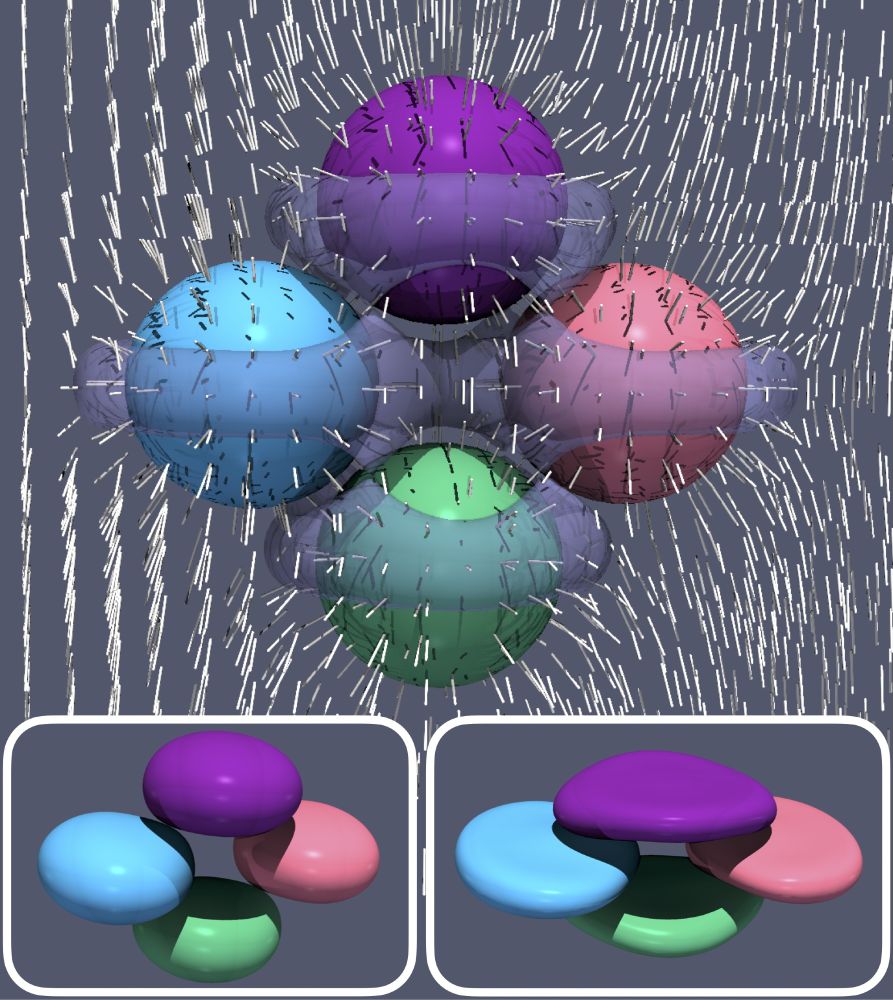
Active soft matter, Fluid mechanics, Biophysics.
https://scholar.google.de/citations?hl=en&user=QLNh8EwAAAAJ&view_op=list_works&sortby=pubdate
doi.org/10.1101/2025...
Here, we describe how confined bacterial suspensions self-organize into structured domains of different motilities, in response to oxygen limitations🦠🍥
Bluetorial follows! [1/8]
Microbial self-organization in response to self-made oxygen gradients! 🦠 🔄 🍥
Microbial self-organization in response to self-made oxygen gradients! 🦠 🔄 🍥
doi.org/10.1101/2025...
Here, we describe how confined bacterial suspensions self-organize into structured domains of different motilities, in response to oxygen limitations🦠🍥
Bluetorial follows! [1/8]
Microbial self-organization in response to self-made oxygen gradients! 🦠 🔄 🍥
Interested in how actin drives cell crawling, eating, dividing, or osmoregulation? What about pathogenesis of a brain-eating amoeba? Or eukaryotic evolution? If so, apply through my website: katrinavelle.wixsite.com/science/cont...
Please share!

Interested in how actin drives cell crawling, eating, dividing, or osmoregulation? What about pathogenesis of a brain-eating amoeba? Or eukaryotic evolution? If so, apply through my website: katrinavelle.wixsite.com/science/cont...
Please share!
Apply by Sept 17th (RTs appreciated!)
jobs.exeter.ac.uk/hrpr_webrecr...
Apply by Sept 17th (RTs appreciated!)
jobs.exeter.ac.uk/hrpr_webrecr...
doi.org/10.1101/2025...
Here, we describe how confined bacterial suspensions self-organize into structured domains of different motilities, in response to oxygen limitations🦠🍥
Bluetorial follows! [1/8]
doi.org/10.1101/2025...
Here, we describe how confined bacterial suspensions self-organize into structured domains of different motilities, in response to oxygen limitations🦠🍥
Bluetorial follows! [1/8]
www.nature.com/articles/s41...

www.nature.com/articles/s41...
doi.org/10.1101/2025...
Here, we describe how confined bacterial suspensions self-organize into structured domains of different motilities, in response to oxygen limitations🦠🍥
Bluetorial follows! [1/8]
doi.org/10.1101/2025...
Here, we describe how confined bacterial suspensions self-organize into structured domains of different motilities, in response to oxygen limitations🦠🍥
Bluetorial follows! [1/8]
(1/n) www.biorxiv.org/content/earl...

(1/n) www.biorxiv.org/content/earl...
In our latest study, led by Rosa, we explored the locomotion and dynamics of living worms—acting as active polymers—navigating a porous environment made of 3D-printed pillar arrays. And we found something surprising...
In our latest study, led by Rosa, we explored the locomotion and dynamics of living worms—acting as active polymers—navigating a porous environment made of 3D-printed pillar arrays. And we found something surprising...
#PNAS by @marlis.bsky.social and late Kevin B. Wood
www.pnas.org/doi/10.1073/...

#PNAS by @marlis.bsky.social and late Kevin B. Wood
www.pnas.org/doi/10.1073/...

🄱🄸🄾🄿🄷🅈🅂🄸🄲🅂
Fascinating work from Sebastian Gonzalez La Corte, Sujit Data, et al at CalTech on polymer-induced entropic attractions that hinder diffusion and lead bacteria to form long spaghetti-like cables within mucus and biofilms
Paper in Science Advances: www.science.org/doi/10.1126/...

🄱🄸🄾🄿🄷🅈🅂🄸🄲🅂
Fascinating work from Sebastian Gonzalez La Corte, Sujit Data, et al at CalTech on polymer-induced entropic attractions that hinder diffusion and lead bacteria to form long spaghetti-like cables within mucus and biofilms
Paper in Science Advances: www.science.org/doi/10.1126/...
www.nature.com/articles/s41...
Work by: Simon Hadjaje, Ignacio Andrade-Silva, Marie-Julie Dalbe and Raphaël Clément
www.nature.com/articles/s41...
Work by: Simon Hadjaje, Ignacio Andrade-Silva, Marie-Julie Dalbe and Raphaël Clément
go.bsky.app/DLUDYX3
#cellbio #SoftMatterPhysics #science
go.bsky.app/DLUDYX3
#cellbio #SoftMatterPhysics #science
www.pnas.org/doi/10.1073/...
With Gloria Canales & @mazi1.bsky.social we studied how the single celled alga Pyrocystis lunula 🌙 move their chloroplast in response to strong light.
Get ready for some fun mechanics, signals and organelle motion! 🧵
www.pnas.org/doi/10.1073/...
With Gloria Canales & @mazi1.bsky.social we studied how the single celled alga Pyrocystis lunula 🌙 move their chloroplast in response to strong light.
Get ready for some fun mechanics, signals and organelle motion! 🧵
A review of 'Rigid and deformable bodies in nematic liquid crystals', with the amazing Tom Chandler, is out today in Phys. Rev. Fluids. @apsphysics.bsky.social 🧪⚛️
journals.aps.org/prfluids/abs...

A review of 'Rigid and deformable bodies in nematic liquid crystals', with the amazing Tom Chandler, is out today in Phys. Rev. Fluids. @apsphysics.bsky.social 🧪⚛️
journals.aps.org/prfluids/abs...
www.umass.edu/fsi/index.html
www.umass.edu/fsi/index.html
Is it one thing or a combination?
Turns out bacteria can’t handle stress either!
Excited to share my first first author paper out now in @currentbiology.bsky.social!
Combining multiple stressors blocks bacterial migration and growth! www.cell.com/current-biol...
Is it one thing or a combination?
Turns out bacteria can’t handle stress either!
Excited to share my first first author paper out now in @currentbiology.bsky.social!
Combining multiple stressors blocks bacterial migration and growth! www.cell.com/current-biol...

Gummy worms!
... or the tracks of cells before (green) vs after (orange) being squashed to a 5 micron ceiling. They tend to crawl faster when squished. Circles are the pillars holding up the ceiling.

Gummy worms!
... or the tracks of cells before (green) vs after (orange) being squashed to a 5 micron ceiling. They tend to crawl faster when squished. Circles are the pillars holding up the ceiling.
Last week I had a blast visiting the Datta Lab and working with @babakvh.bsky.social and @meeraramaswamy.bsky.social to watch cells dig into a 3D matrix! Bluesky doesn't have a video option yet, so here's a max intensity projection of a video (LUT: CM Ocean Deep, inverted)

CommsBio Review by Kasper Kragh, Tim-Tolker Nielsen and Mads Lichtenberg
www.nature.com/articles/s42...

CommsBio Review by Kasper Kragh, Tim-Tolker Nielsen and Mads Lichtenberg
www.nature.com/articles/s42...
www.cambridge.org/core/journal...

www.cambridge.org/core/journal...


